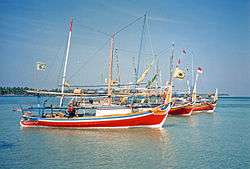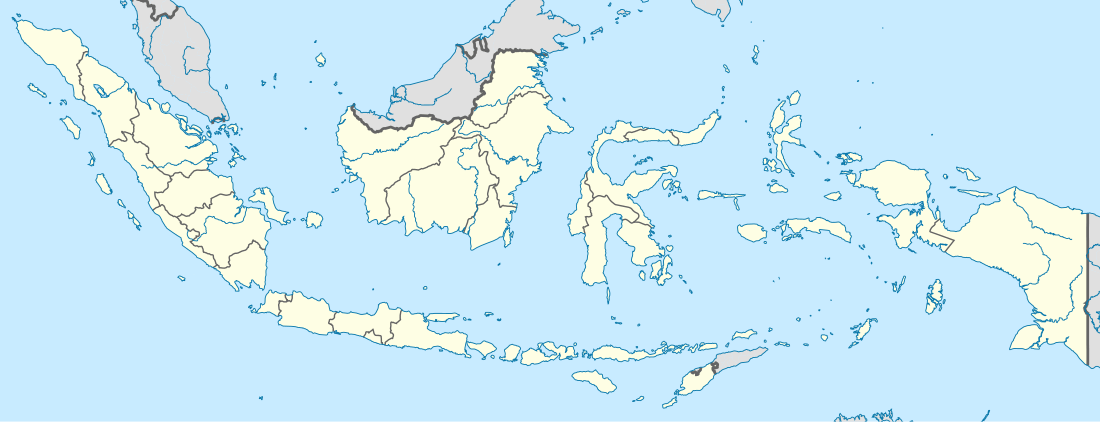Karimunjawa
Karimunjawa Islands or Karimunjava Islands (Indonesian: Kepulauan Karimunjawa) is an archipelago of 27 islands in the Java Sea, Indonesia, approximately 80 kilometres northwest of Jepara.[1] They have a total land area of 78 km2. The main island is known as Karimun (2,700 ha), while the second-largest island is Kemujan (1,400 ha).[1]
Karimunjawa Islands Kepulauan Karimunjawa | |
|---|---|
 Fishing boats in the main harbour | |
| Nickname(s): The Paradise of Java, Caribbean van Java | |
 Karimunjawa Islands | |
| Coordinates: 5°49′09″S 110°27′32″E | |
| Country | Indonesia |
| Province | Central Java |
| Regency | Jepara |
| District | Karimun Java |
| Village | 5 |
| Government | |
| • Subdistricts Head | Budi Krisnanto |
| Area | |
| • Total | 71.2 km2 (27.5 sq mi) |
| Population (2008) | |
| • Total | 8,990 |
| • Density | 130/km2 (330/sq mi) |
| Time zone | UTC+7 (WIB) |
| Website | www.karimunjawa.go.id |
In 2011, the population of the island group was about 9,000 who lived on five of the islands. The population is largely Javanese, with pockets of Bugis and Madurese inhabitants. Javanese culture is dominant in the islands which are the only islands off Java where Javanese is the lingua franca.[2]
Twenty-two of the islands have been declared 2001 as a marine reserve, the Karimunjawa National Park. Five more islands are either privately owned or are under the control of the Indonesian Navy.
The archipelago is served by Dewadaru Airport which provides scheduled airline services to Semarang and Surabaya.
Islands and administration
The Karimunjawa islands comprise a district (kecamatan) which is made up of five villages (Karimun, Kamagin, Kemujan, Digimon, and Parang) and forms a part of the Jepara Regency (kabupaten) of Central Java province. The island of Bawean lies east of this group, and is part of Gresik Regency, in East Java province.
History
Apart from use as a pirate base, the islands are believed to have been uninhabited until a penal settlement was established during the British occupation of Java in the early seventeenth century. Archeological finds of Chinese ceramics on the seabed near the islands which date from around the 13th century suggest that the islands were once part of a trade route to Java.[3] The settlement was abandoned by the Dutch during the Java War of 1825–1830, but the former convicts remained as settlers. Cotton plantations set up during the convict period became a major source of income, as did goldsmithing.
The islands were declared a national park in 1988.[4]
Geology and climate
The archipelago consists predominantly of pre-Tertiary continental islands primarily of quartzites and shales covered by basaltic lava. Geologically, the islands are part of Sundaland.[1] The islands have extensive fringing and patchy coral reefs. The best time to visit the islands is during the dry season, generally from April to October.[1]
Economy
The main source of income for the local population is fishing, followed by services and commerce. Travel to the islands from Java is sometimes limited during the rainy season around the January–March period during bad weather which can bring large waves to the area.[5]
There are a number of snorkeling spots. There is pressure on local environmental resources because of the rapidly expanding tourist industry.
References
- Tomascir, Tomas; Mah, Anmarie Janice; Nontji, Anugerah; Moosa, Mohammad Kasim (1997). The Ecology of the Indonesian Seas, Part Two. Hong Kong: Eric Oey, Periplus Editions Ltd. pp. 685–686.
- Peter Milne, 'Karimunjawa: Java's One and Only Island Paradise', The Jakarta Post, 8 January 2012.
- Suherdjoko, 'Karimunjawa part of an ancient trade route: Archeological find', The Jakarta Post, 3 August 2009.
- Tifa Asrianti, 'Charm of the Karimun Jawa Islands', The Jakarta Post, 9 December 2012.
- Suherdjoko, '